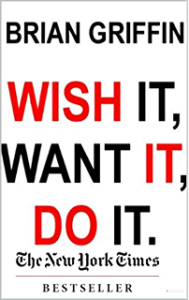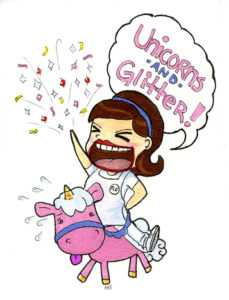
There’s an episode of Family Guy in which Brian (the dog) writes a bestseller called “Wish it. Want it. Do it.” In an interview, he’s called out for having the last 200 pages blank so that readers can make plans and notes. Ultimately, he’s chased off the set of a panel show with a newspaper after urinating on the set.

FUN FACT: You can actually get this book ON AMAZON.
The whole episode is a bit of scathing review of self-help books and the idea that you can get things for yourself or improve your success simply by wishing for it or wanting it hard enough.
Not quite.
The doing is pretty important, too.
But there is evidence to suggest that THINKING about what you want to do and PICTURING yourself doing it can help you prepare for big events more effectively and learn skills more quickly.
Visualizing a skill or task can actually decrease the time that it takes for you to master said skill/task.
It’s true!
Our brains have a hard time distinguishing between imaginary events and real ones. At least in terms of what we’ve already accomplished. That means that mentally picturing events, walking through them as though you’re actually there, and visualizing what success looks like in context can aid you in your ultimate performance.
Whether it’s roller derby or basketball. Playing the piano or the violin. Or building a tree house bed.
Practicing visualization makes us more efficient and effective without necessarily having to kit up or DO THE THING*. Visualizing performances (like game day) is super important for success. When you’ve imagined doing something 1,000 times, it starts to feel like you’ve ACTUALLY done that thing 1,000 times.
When visualizing specific skills, break them down and picture yourself completing each part effectively. Make sure that your visualization is as vivid as possible.
WISH IT.
If you’re ready to start plugging your brain into the visualization Matrix, give these specific types of visualization a try:
SKILL VISUALIZATION
Is there a specific skill that you’re struggling to master no matter how much time you put into it on-skates?
Double your productive practice time by thinking about how you’ll accomplish the skill.
Picture yourself executing each part of the skill correctly. If there’s a particular sticking point that you know you have when you physically complete the skill, spend the most time visualizing that specific part of the skill and what it takes to be successful. Get the parts of your brain in charge of the move firing without even needing to do it.
Then, build up to imagining that you are easily completing the entire skill. Being able to “see” yourself mastering the basics helps you to better understand the skill. And your body (muscles included) react, at least in part, to what you are picturing.
PERFORMANCE VISUALIZATION
It’s game time. Picture the entire scene.
- What does it look like?
- What does it sound like?
- How do you feel?
- How are you playing?
This works best if you start by remembering what your last game or performance felt like. Then, building off those moments.
Starting with memories helps because it will drop your brain (and body) into a more vivid feeling of your performance. The key to a solid visualization is to make it as vivid as possible. Does your venue smell like hot dogs? Then you better smell hot dogs in your visualization, too.
Take the times in your last performance that you were particularly successful and relive those. Try to identify what clicked and why it felt so good as a way to recapture that next time.
Take the times in your last performance that you didn’t perform the way you hoped and re-write them. What would it look like if you were performing the way you wanted to? How would it feel? What would the results of the be?
You may not be able to fix what you’ve done in the past, but you can mentally prep for those same situations in the future. And that’s what visualization is good for.
WANT IT.
Visualization isn’t all unicorns and glitter. As much as we might wish it could be…
Preparing fully for a game or performance requires that you visualize ALL THE THINGS that could happen. Even the best athletes and performers don’t simply go out and play 100% perfectly.
We all make mistakes and being able to visualize those is an important part of the practice, too.
INCLUDE ADVERSITY
When you sit down to hash out game day in your brain, you not only need to be thinking about ways that you’ll succeed but also those situations that might not go your way.
Be realistic. What adversity might you face? How will you overcome it?
Adversity is a very real part of sports. Being able to overcome it is just as important as avoiding it altogether. Because it WILL happen.
If you end up in the box for the 4th time in 3 jams, how are you going to react? Does that change your game? If so, how?
Really contemplate what adversity you typically come across in games and visualize that, too. Sometimes our biggest obstacles aren’t our skills, but our reactions.
DO IT.
Set aside 10 minutes each night over the next 3 days to visualize yourself doing something that you want to accomplish or mentally rehearsing your next game. The more you imagine it, the easier it is to make it a reality.
After all, your brain doesn’t know the difference.
*You still have to do the thing. Wishing it and wanting it aren’t enough, no matter how hard you do them.
Want More?
This blog post is an early edition piece from Train Your Brain to Shut Up. A book developed specifically to provide athletes with the tools to improve their mental game. This journal gives you the tools to build an athletic mindset that supports—instead of sabotages —your performance.
Just like your physical training, your mental training is integral to your success in-game. And it takes practice and training to get it the way that you want you. With this journal, you’ll learn:
- What mindset is (and what it isn’t).
- Why (and how) to build an anti-anxiety pre-game routine.
- To recognize your negative thoughts without letting them sink you.
- Tricks to flip your thoughts into something less negative.
- Ways to turn around “bad” practices or games.
- A consistent way to PRACTICE your athletic mindset.
Focused journal prompts to work on your mental game all wrapped up in a package you can fit inside your kit bag.
GET YOUR COPY HERE


